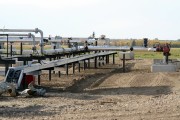If you followed coverage of the federal budget last week with an eye to environmental issues, you could be excused for thinking Canada’s environmental review process is a tangled web of unnecessary red tape that is stifling investment in Canada’s energy sector.
Building on the theme that Natural Resources Minister Joe Oliver has been doggedly repeating in stops across the country, last week’s federal budget documents argue that the environmental review process needs to be unraveled in order to attract capital and keep Canada’s economy moving forward. It would make sense if it weren’t based on such a phony premise.
To illustrate the need to slash all that red tape, the government repeatedly points to Exhibit A: the fact that it took six years for the federal government to approve the Total Joslyn oilsands mine. Six years does seem like a long time — until you consider one important fact: mid-way through the process, the oilsands company behind the project chose to completely change its approach to extracting the bitumen from the oilsands and managing the resulting tailings waste, and submitted a new application for the project, essentially hitting re-set on the regulatory review.
The reality is, oilsands expansion is moving along just fine. More than a million barrels of new production have been approved in the last five years alone — that’s the equivalent of approving a giant new oilsands mine every single year. Industry sources tell us there is more than $200 billion of proposed new oilsands investment in the cards. Not bad for a regulatory system that’s supposedly so complex and burdensome as to scare away investment.
After spending 20 years working on oilsands issues — experience that includes reviewing in detail the environmental assessments for all the major projects and consulting for some oilsands producers on innovative technologies — we know that effective environmental assessment is a cornerstone of sustainable economic development.
To date, companies have proposed quadrupling oilsands production. Given this planned increase in output, it seems reasonable that our government ought to be enhancing — not reducing — Canada’s capacity to assess the impacts of this level of activity. Yet the new federal budget proposes a 40 per cent budget cut for the Canadian Environmental Assessment Agency.
If the government truly has an interest in efficient decision-making, why make such drastic cuts to the budget of the very agency charged with making those decisions? A cynic might say the federal government is looking to get out of the business of environmental management altogether — despite its obligation to show due diligence and protect the environment on behalf of all Canadians.
Rather than presenting a barrier to investment, a strong regulatory system is key to attracting capital by ensuring a stable and predictable playing field for investors. Controversy over environmental mismanagement and the government’s apparent unwillingness to set and enforce environmental rules compromise Canada’s ability to export or market oilsands — these factors pose far bigger long-term risks to prospective developers than Canada’s current environmental review process.
In the case of the oilsands in particular, various independent commentators have pointed to the fact that the current rapid pace and scale of development has already surpassed the government’s ability to manage environmental impacts. This fact is perhaps best illustrated by the recent and embarrassing admission that the governments of Alberta and Canada don’t even have the baseline monitoring in place that could inform reasonable decision-making.
The Harper government’s push to weaken the Canadian Environmental Assessment Act and the Fisheries Act seems driven more by ideology than by evidence. Indeed the Royal Society of Canada’s recent review of environmental management in the oilsands suggested the federal government needs to do more, stating: “The current visibility of relevant provincial and federal agencies, in particular in dealing with the major environmental challenges is low, and is generally not in line with those challenges.”
This message seems to have been lost on the federal government — rather than rising to the challenge, Ottawa is now proposing to do even less. Tweaking the environmental review process to increase efficiency is one thing, but speeding approvals by abdicating the federal responsibility to ensure appropriate environmental management is not acceptable. In many cases, federal laws are stronger than provincial rules, and the impacts of industrial mega-projects often cross provincial borders, which is why Canadians will lose out if the federal government backs away from its responsibilities in line with what is outlined in the budget.
With the proposed changes to the environmental review process, Canadians will get weaker, less-informed decision-making, sloppy mitigation by developers, and the risk of greater environmental impacts (impacts that might otherwise be avoidable). The emphasis needs to be on increasing attention to measuring and managing the negative impacts of development, not rolling back protections in the manner that has been proposed.
It is true there are many unacceptable delays in the regulation of the oilsands — but you won’t hear about them from the federal government.
In 2008, Harper gave a speech in London in which he stated Canada would require oilsands emissions reductions equivalent to what would be achieved through the implementation of carbon capture and storage and that “new oil sands operations will only be permitted if they can massively reduce their emissions.” Those turned out to be hollow words. Four years later, we still have no federal regulation of greenhouse gas pollution of the oilsands sector — risking Canada’s long term competitiveness as many countries start to prioritize low-carbon alternatives.
A legally mandated recovery plan for threatened woodland caribou is now five years overdue. Meantime, despite repeated requests from regulatory panels for the federal government to ensure the aquatic environment is protected, the government still has not set low flow limits that would require oilsands companies to turn off the pumps to protect the Athabasca River.
These are the delays that are making headlines around the world, puzzling our customers and damaging Canada’s reputation as a responsible and reliable business partner. If the federal government wants to improve the regulatory process for new energy projects, the best thing it could do is deliver on the promises it has made to Canadians and our customers and demonstrate that it takes its responsibility as a regulator seriously.





